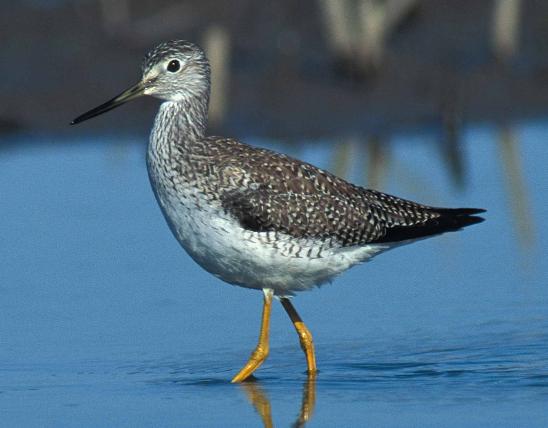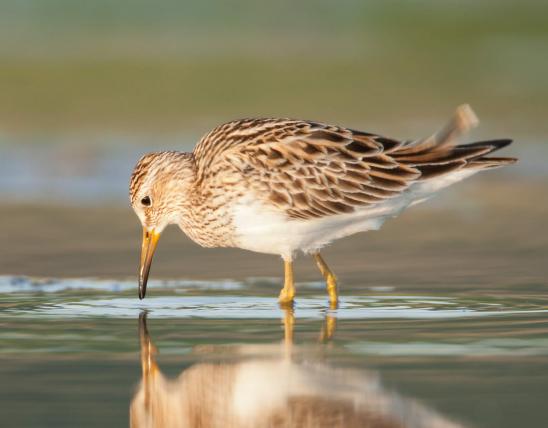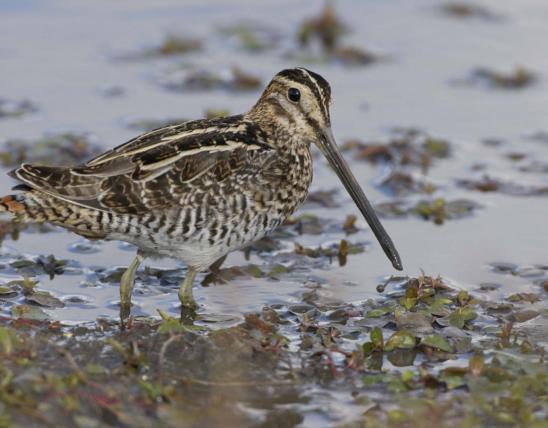
Lesser yellowlegs are streaked and spotted with gray and black on the upperparts, breast, and sides; the belly and rump are white. Legs are bright yellow. The bill is black, slender, straight, and less than one and a half times the length of the head, measured along the same line as the bill. The call is a soft “tu” or “tu tu.” Alarmed individuals will call many times.
Similar species: A classic birding ID challenge is to distinguish between the lesser yellowlegs and the nearly identical greater yellowlegs. The two yellowlegs species are fairly easy to tell apart when they are standing together, but it is harder when you see them alone. Side by side, the lesser yellowlegs is indeed smaller, and it seems daintier. Note also that the greater yellowlegs’ bill is slightly upturned (not straight), and its bill is proportionately longer, more than 1.5 times the head (measured along the same line as the bill).
Length: 11 inches.

Statewide.
Habitat and Conservation
Like other shorebirds, the lesser yellowlegs lives in a variety of wetland and shoreline habitats. Most Missourians see lesser yellowlegs as they are foraging in shallow water in flooded pastures, flooded row-crop stubble, mudflats, shorelines, and marshes.
Food
Forages in shallow water and along shorelines for worms, snails, crustaceans, larval and adult flies, beetles, and other insects, and other invertebrates.
Status
Common migrant.
Populations may be declining. Possible causes include loss of wetland habitat in this species’ winter range. Like many other birds that breed in northern Canada, this species is highly vulnerable to climate change. As the overall climate gets warmer, there is little land to the north to which they might shift their nesting range.
This species was overhunted in the past, but the Migratory Bird Treaty Act of 1918, which banned hunting of this and other migratory species in mainland North America, helped populations to rebound.
Life Cycle
Lesser yellowlegs migrate through Missouri in spring and fall. In spring, they appear in the second half of March, their numbers peak in late April and early May, and they have left by the end of May. The earliest fall migrants begin appearing in early July, their numbers peak in late August and early September, and they are gone by mid-October.
They breed in Alaska and northwestern Canada, in areas with grasses and other vegetative cover. Like its relatives, the lesser yellowlegs nests on the ground, in a fairly simple depression lined with grasses, sedges, mosses, and so on. Clutches comprise about 4 eggs, and there is only 1 brood a year. Eggs hatch in about 3 weeks; upon hatching, the young are covered with down and are soon able to leave the nest and start foraging.
The winter territory includes U.S. Pacific, Gulf, and Atlantic coasts, Florida, the Bahamas, southern Texas, and south into Central and South America.
Human Connections
The Migratory Bird Treaty Act and other conservation laws rescued many birds from possible extinction. Few of us are alive to remember the early 20th century, so it is tempting to take conservation laws — and their results — for granted. But it is sobering to read old accounts from the days when many species were edging toward extinction. Here is one report on the status of lesser yellowlegs from 1916: “No longer ago than 1870 the flocks were quite numerous. . . . I remember that they were always watchful, but they were readily attracted by a whistled imitation of their call, and if even one was shot out of the flock the others hovered about until many had paid the penalty of their sympathetic concern. Of late years at those same ponds, a single bird or a pair is seen occasionally, but the flocks are gone, perhaps never to return.” Today’s conservation challenges often revolve around protecting the habitats that plants and animals need.
Ecosystem Connections
Lesser yellowlegs are predators that eat insects and other small animals. Thus they help maintain balance in the populations of those animals.
A variety of animals prey on these ground-nesting birds and their eggs and young. Predators — foxes, for example — rely on healthy populations of their prey species to survive.
As a migratory species, the lesser yellowlegs plays a role in all the places it travels to and through, from its breeding grounds in northern Canada to its summer home in Central and South America — plus all the territory in between, including the United States. This is a good example of why effective conservation must involve international efforts. In this case, most of the Western Hemisphere.




















About 350 species of birds are likely to be seen in Missouri, though nearly 400 have been recorded within our borders. Most people know a bird when they see one — it has feathers, wings, and a bill. Birds are warm-blooded, and most species can fly. Many migrate hundreds or thousands of miles. Birds lay hard-shelled eggs (often in a nest), and the parents care for the young. Many communicate with songs and calls.


























